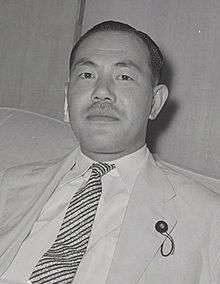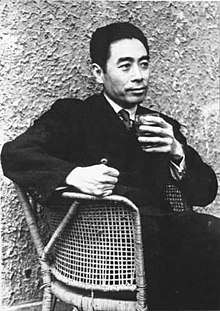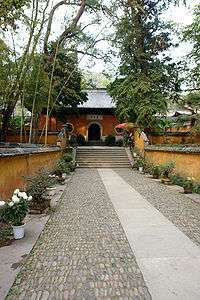Guoqing Temple
| Guoqing Temple | |
|---|---|
| 國清寺 | |
|
The Guoqing Monastery. | |
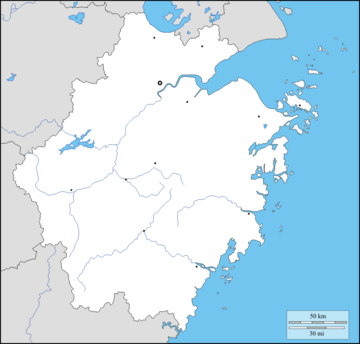 Shown within Zhejiang  Guoqing Temple (China) | |
| Basic information | |
| Geographic coordinates | 29°10′23″N 121°02′33″E / 29.173141°N 121.042594°ECoordinates: 29°10′23″N 121°02′33″E / 29.173141°N 121.042594°E |
| Affiliation | Buddhism |
| Sect | Tiantai |
| Prefecture | Taizhou |
| Province | Zhejiang |
| Country | China |
| Year consecrated | 598 |
| Architectural description | |
| Architectural style | Chinese architecture |
| Founder | Emperor Yang of Sui |
| Date established | 598 |
| Completed | 1734 (reconstruction) |
The Guoqing Temple (simplified Chinese: 国清寺; traditional Chinese: 國清寺; pinyin: Guóqīng sì; Wade–Giles: Kuo-ch'ing Ssu) is a Buddhist temple on Mount Tiantai, in Taizhou, Zhejiang Province, China. Originally built in 598 during the Sui Dynasty, and renovated during the reign of the Qing Yongzheng Emperor (r. 1722–1735), the temple is located roughly 220 kilometres (140 mi) from the city of Hangzhou. It was the initial site for the creation of the Tiantai school of Mahayana Buddhism, founded by Zhiyi (538–597 AD). The temple covers an area of some 23,000 m2 (250,000 sq ft) and features 600 rooms in a total of 14 different halls, including the Grand Hall of Sakyamuni, the Hall of Five Hundred Arhats and the Hall of Monk Jigong. The exterior of the building features Chinese pagodas such as the Sui Pagoda, the Seven Buddha Pagoda, and the Memorial Pagoda of Monk Yi Xing (683–727 AD).[1][2]
History
In 598, according to Master Zhizhe's last wish, the ruler of Sui dynasty (581–618) built Guoqing Temple on Mount Tiantai. The Tiantai sect is the first Chinese Buddhist sect to evolve from the original Buddhism after it was spread to China. Its founder, Master Zhizhe, lived on Mount Tiantai in Zhejiang for a long time - hence the name Tiantai sect.[1][2]
In the Tang dynasty (618–907), a large number of Japanese diplomats came to China. In the second year of the Zhenyuan Period, namely AD 804, the eminent Japanese monk Saichō came with the diplomats. He learned the Tiantai doctrine in Guoqing Temple on Mount Tiantai introduced by Lu Chun, prefectural governor of Ningbo, Zhejiang. One year later, Saicho returned to Japan. Since then, the Guoqing Temple became the cradle of the Tiantai sect in Japan.[3][4]
Renovation of Guoqing Temple in the PRC era
In 1972, in order to restore Japan - China diplomatic relations, the Japanese Prime Minister Kakuei Tanaka paid a visit to China to which the Chinese government attached great importance and made proper arrangements.[5]
During Kakuei Tanaka's visit, he proposed a personal request to Prime Minister Zhou Enlai. Kakuei Tanaka wanted to worship at the Guoqing Temple because it was the cradle of Tendai Buddhism in Japan. Kakuei Tanaka's mother was a devout follower of Tendai, who, before he visited China, had asked him to worship in the Guoqing Temple for her.[5]
After Kakuei Tanaka's request, Zhou Enlai made inquiries to the relevant departments of Zhejiang province. However, he was told that the Guoqing Temple couldn't receive the Japanese guest at that time as it had not been repaired for many years. Zhou Enlai had to tell him euphemistically that the Guoqing Temple was being renovated but that after the renovation, he would receive an invitation. Although Kakuei Tanaka felt it was a pity, he was rather happy with the gracious invitation of China.[5]
After Kakuei Tanaka returned to Japan, Zhou Enlai asked to start the renovation plan for Guoqing Temple immediately and required that the temple should be renovated by 1975. After receiving the notification document, the government of Tiantai County immediately established the Tiantai County Guoqing Temple Restoration Committee.[5]
Because of the Cultural Revolution, some of the ancient buildings inside the Temple had been in a state of disrepair for many years. Many original Buddha statues and musical instruments of the temple had been lost. The Restoration Committee gave notice to all units and people of the whole county to find these cultural relics of the Guoqing Temple. The Restoration Committee was quickly rewarded. The Five Hundred Arhat statues of the temple were found stored in a farm implements factory in Tiantai County. Some were incomplete, some had no head, some had no hands, and some had no feet. There were 323 Arhat statues in total. They also found a large bronze musical stone (铜磬) with inscriptions in another storehouse. It was cast in the Qing dynasty (1644–1911). In addition, horizontal inscribed boards (匾额) were also found in a cotton textile mill in the same county.[5]
Although the workers found part of the original cultural relics, the quantity was too small. The State Council permitted the Restoration Committee to select and transport some Buddha statues and sacrificial vessels to Guoqing Temple. The Committee went to the Palace Museum, Yonghe Lamasery, Beijing Cultural Relics Management Office and other units of cultural relics to select Buddha statues and musical instruments. A total of 109 cultural relics were selected and transported to Guoqing Temple, which were packed in 12 big cases.[5]
As these cultural relics were many, some of them being huge Buddha statues, the parties concerned decided to transport them by train. The railway sector arranged two specialized train carriages to transport them. Among the relics, the largest was the statue of Sakyamuni of the Ming dynasty (1368–1644); it is a heavy as 13 tonnes. The workers transferred a heavy duty crane to load the statue. The two loaded train carriages went directly to Hangzhou without stopping on the way. When the statue of Sakyamuni arrived in Guoqing Temple the Restoration Committee invited some water conservancy workers who were working nearby to help. With this joint effort, the statue of Sakyamuni finally sat in the middle of the Mahavira Hall, with 18 Arhat statues, in order, on the two sides of the hall. The large bronze tripod of Qianlong Period of the Qing dynasty (1644–1911) stood right in front of the Mahavira Hall. Two white marble lions were placed before the gate of the temple.[5]
In addition to looking for Buddhist relics, the workers had to restore the endangered cultural relics of Guoqing Temple. The Restoration Committee invited 78 folk craftsmen to join the restoration of Guoqing Temple. During the restoration of the horizontal inscribed boards and couplets on the pillar of the temple it was discovered that some characters on these horizontal inscribed boards and couplets had been lost or damaged.[5]
In order to restore these incomplete cultural relics, the craftsmen used a unique skill, namely "dried lacquer and ramie process" (干漆夹苎). The craftsmen used 13 raw materials, such as raw lacquer, ramie, colorful stone powder and tung oil to wrap and glue the linen and paint which they then polished repeatedly. Then, they painted auxiliary materials, such as cinnabar, at last, they pasted gold foil.[5]
After careful calculation and strict budgeting, the craftsmen figured out that 2.5 kilogram gold was needed to decorate and embellish relics like Buddha statues. Gold was then a scarce resource. However, for the renovation of Guoqing Temple, the relevant department approved of this request at last.[5]
In addition to renovating and repairing the original cultural relics, workers of Restoration Committee elaborately designed some sculptures and items inside the temple. Two mysterious Buddha's warrior attendants inside Guoqing Temple were reshaped by the craftsmen. Their shaped are unique in China. Besides, the altar (供桌) in the Mahavira Hall were also built by the craftsmen. They added traditional Buddhist elements to the design, and strove for perfection in the depiction of details. They spent over 300 labor-hours on the carve patterns on the altar.[5]
In the southwest corner of Guoqing Temple, there is a pond for freeing life. Beside the pond are the "Yuleguo (fish's paradise)" stele (鱼乐国) inscribed by Dong Qichang, a famous calligrapher of the Ming dynasty (1368–1644), and an imperial monument from the Qianlong Emperor respectively. When renovating Guoqing Temple, the workers transported ten black carp from Linghu Nuresery (菱湖渔场), Jiaxing, Zhejiang, reproducing the vitality of fish's paradise.[5]
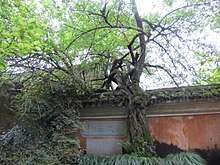
During the renovation, an ancient prune tree which was planted in the Sui dynasty (581–618) over 1300 years ago in Guoqing Temple came back to life miraculously, which added a charming landscape to the temple. With unremitting efforts of the workers, Guoqing Temple's renovation was completed as scheduled.[5]
On October 18, 1975, the first delegation of Japanese guests was received.[5]
National treasures
The large bronze tripod (青铜鼎) cast in Qianlong Period of the Qing dynasty (1644–1911) of China cames from the Palace Museum. Its shape is simple, unsophisticated and elegant. With two ears and three feet, it is 3.8-metre (12 ft) high overall, with the four big characters of "Sheng Shou Wu Jiang" (圣寿无疆). The tripod is decorated with three lions playing ball wheel of life, conch and other eight-treasure patterns. Exquisitely patterned it is of very high artistic vallce. Over 40 years ago, it was collected in the Palace Museum in Beijing. Now it belongs to Guoqing Temple more than a thousand miles away from Beijing.[5]
The statue of Sakyamuni is a bronze statue made in the Ming dynasty (1368–1644).[5][6]
The 18 Arhat statues come from Yonghe Lamasery. They are high-quantity works carved with nanmu in the Yuan dynasty (1271–1368).[5][6]
The two white marble Chinese guardian lions come from Beijing and were carved in the Qing dynasty (1644–1911).[5]
Significance
This mountain temple is the site where indigenous Chinese Buddhism branched away from Buddhist teachings and doctrine commonly found in India. From there, the Tiantai sect of Buddhism spread to both Korea and Japan during the Tang Dynasty (618–907 AD). The tall brick Guoqing Pagoda built at the temple in the year 597 AD is still standing,[7] making it one of the oldest surviving brick pagodas in China (after the 40 metres (130 ft) tall Chinese Songyue Pagoda built in 523 AD).
Gallery
See also
References
Bibliography
- Zhang Yuhuan (2012a). "The Cradle of Tiantai Buddhism: Guoqing Temple in Mount Tiantai" 《天台宗祖庭:天台山国清讲寺》. 《图解中国著名佛教寺院》 [Illustration of Famous Buddhist Temples in China] (in Chinese). Beijing: Contemporary China Publishing House. ISBN 978-7-5154-0135-5.
- Zhang Yuhuan (2012b). "The Cradle of Tiantai Buddhism: Guoqing Temple in Mount Tiantai" 《天台宗祖庭:天台山国清讲寺》. 《图解中国佛教建筑》 [Illustration of Buddhist Architecture in China] (in Chinese). Beijing: Contemporary China Publishing House. ISBN 978-7-5154-0118-8.
Further reading
- Steinhardt, Nancy Shatzman. "The Tangut Royal Tombs near Yinchuan," Muqarnas: An Annual on Islamic Art and Architecture (Volume X, 1993): 369-381.
